In this section, I'll look at some additional examples of groups. Some of these will be discussed in more detail later on.
In many of these examples, I'll assume familiar things like associativity of addition or multiplication. A really careful discussion would often require an extensive discussion of foundations: For instance, associativity of addition for the integers would require a discussion of how the integers are constructed.
Example. ( The integers mod
n) ![]() (read "Z mod n") denote
the set of equivalence classes of integers under equality mod n. It's
a group under addition mod n.
(read "Z mod n") denote
the set of equivalence classes of integers under equality mod n. It's
a group under addition mod n.
If a and b are integers and n is a positive integer (in most cases,
![]() ), then a and b are congruent mod
n if n divides
), then a and b are congruent mod
n if n divides ![]() . In this case, you write
. In this case, you write ![]() .
.
For example, -6 and 36 are congruent mod 14, since 14 divides ![]() .
.
Equality mod n is an equivalence relation on
![]() , and therefore
, and therefore ![]() is partitioned into equivalence classes. For example, the equivalence
classes of integers mod 4 are
is partitioned into equivalence classes. For example, the equivalence
classes of integers mod 4 are
![]()
![]()
![]()
![]()
To say that this is a partition of ![]() means that every integer is in exactly one of these
sets.
means that every integer is in exactly one of these
sets.
Thus, ![]() . Add elements of
. Add elements of ![]() by adding and reducing mod n. Thus, in
by adding and reducing mod n. Thus, in ![]() ,
,
![]()
Relative to congruence mod n, there are n equivalence classes: The
class containing 0, the class containing 1, ..., the class containing
![]() . As usual, I'll abuse notation and denote the
equivalence classes by 0, 1, ...,
. As usual, I'll abuse notation and denote the
equivalence classes by 0, 1, ..., ![]() . Then
. Then ![]() is the set of these n equivalence classes.
is the set of these n equivalence classes.
Addition mod n gives a binary operation on ![]() . It is associative, and the identity is 0. If
. It is associative, and the identity is 0. If ![]() , then the inverse of k is
, then the inverse of k is ![]() .
.
With these definitions, ![]() is a group. It
is called the cyclic group of order n.
is a group. It
is called the cyclic group of order n.
I'll take the axioms for granted right now; later, they will follow
from the construction of ![]() as a quotient group of
as a quotient group of ![]() .
.![]()
Example. Find the order of 6 in ![]() .
.
![]()
The operation is addition and the identity is 0. To find the order of an element, I find the first positive multiple which equals 0.
Thus, 6 has order 5, because
![]()
Example. ( Guessing an
identity and inverses) Define an operation ![]() on the real numbers by
on the real numbers by
![]()
Does this give a group structure on ![]() ?
?
![]() takes two real numbers and produces a real number, so
takes two real numbers and produces a real number, so
![]() is a binary operation on
is a binary operation on ![]() .
.
Next, I'll check associativity. Let ![]() . Then
. Then
![]()
![]()
Thus, ![]() , so
, so ![]() is associative.
is associative.
Next, I have to determine whether there is an identity for ![]() . First, I'll work backwards to guess what
the identity should be. This is not a proof! Once I have my
guess, I'll confirm my guess (if possible).
. First, I'll work backwards to guess what
the identity should be. This is not a proof! Once I have my
guess, I'll confirm my guess (if possible).
Suppose e is the identity. Then in particular, ![]() (I picked 3 at random). This means that
(I picked 3 at random). This means that ![]() , or
, or ![]() .
.
My guess is that the identity is -2. To see if it works, let ![]() . Then
. Then
![]()
This proves that -2 is the identity for ![]() .
.
Finally, I want to show that every element has an inverse. Since -2
is the identity, this means that for every element a, I must find an
element ![]() such that
such that ![]() and
and ![]() .
.
As I did in the identity step, I'll guess ![]() by working backwards, then confirm my guess. Since I
want a formula for
by working backwards, then confirm my guess. Since I
want a formula for ![]() in terms of a, I'll
work with an arbitrary
in terms of a, I'll
work with an arbitrary ![]() --- in contrast to picking
a random element of
--- in contrast to picking
a random element of ![]() , as I did to find the identity.
, as I did to find the identity.
Start with ![]() . This means that
. This means that ![]() , so
, so ![]() .
.
(Be sure you understand why I'm not finished yet! Finding ![]() does not prove that inverses
exist. Think about the reasoning: I started with
does not prove that inverses
exist. Think about the reasoning: I started with ![]() , which assumes that
, which assumes that ![]() is defined. I need to confirm that
is defined. I need to confirm that ![]() is the inverse of a under
is the inverse of a under ![]() , which I do by direct computation.)
, which I do by direct computation.)
I have
![]()
Therefore, ![]() is the inverse of a.
is the inverse of a.
I've verified all the axioms, so ![]() is a group under the
operation
is a group under the
operation ![]() .
.![]()
Example. ( A left identity
and right inverses) Let ![]() denote the
nonzero reals. Define a binary operation on
denote the
nonzero reals. Define a binary operation on ![]() by
by
![]()
(The operation is ![]() , and I multiply as usual on the
right side.)
, and I multiply as usual on the
right side.)
Show that the operation is associative, has a left identity but not a
right identity, and has right inverses but not left inverses. If a
and b are nonzero real numbers, so is ![]() . Therefore, the set is closed under the
operation.
. Therefore, the set is closed under the
operation.
Let ![]() . Then
. Then
![]()
1 is a left identity, in the sense that ![]() for all
for all ![]() . But
(for example)
. But
(for example)
![]()
In other words, 1 is not a two-sided identity, as required by the group definition.
There are also right inverses: ![]() for all
for all ![]() . But (for instance) there is no
. But (for instance) there is no ![]() such that
such that ![]() , since
, since
![]()
![]() with
with ![]() is not a group. This
example shows why you have to be careful to check the identity and
inverse properties on "both sides" (unless you know the
operation is commutative).
is not a group. This
example shows why you have to be careful to check the identity and
inverse properties on "both sides" (unless you know the
operation is commutative).
Note: It is true that if an associative operation has a left identity and every element has a left inverse, then the set is a group.![]()
Example. ( A group which is a subset of the integers) Let
![]()
Is G a group under integer addition? (Assume that integer addition is associative.)
First, I'll check whether integer addition actually gives a binary operation on G. To do this, I need to check whether the set is closed under the operation. I'll take two arbitrary elements of G, add them, and see if the sum is an element of G.
Let ![]() . Then
. Then
![]()
To show that the sum is in G, I have to write it in the form of a typical element of G, namely
![]()
Note that I didn't pick two specific elements of G (like "22" and "0"): I used two general elements.
I also didn't use "![]() " and "
" and "![]() ", since that would be using the same element
twice.
", since that would be using the same element
twice.
Now I know that addition gives a binary operation on G.
I'm assuming that addition is associative.
Next, I must show that G has an identity element. 0 is an identity element for addition of integers, so it will work for elements of G:
![]()
However, I also have to show that 0 is in G! To do this, write it as
![]() :
:
![]()
Therefore, 0 is the identity element of G.
Finally, let ![]() . I must show that it has an
inverse under addition. The ordinary additive inverse works:
. I must show that it has an
inverse under addition. The ordinary additive inverse works:
![]()
However, as with the identity 0, I have to show that ![]() is in G. To do this, just rewrite it so it has the
correct form:
is in G. To do this, just rewrite it so it has the
correct form:
![]()
This shows that every element of G has an inverse.
Therefore, G is a group.![]()
Example. ( Symmetry groups) A regular n-gon is a closed, convex polygon in the plane with n equal sides. For example, a regular 3-gon is an equilateral triangle, and a regular 4-gon is a square.
A rigid motion of the plane is a map ![]() which preserves distances.
which preserves distances. ![]() , the dihedral group of order
, the dihedral group of order
![]() , is the group of rigid motions of the plane which
carry a given regular n-gon onto itself. (Such a rigid motion is said
to preserve the figure. It is also called a
symmetry of the figure.)
, is the group of rigid motions of the plane which
carry a given regular n-gon onto itself. (Such a rigid motion is said
to preserve the figure. It is also called a
symmetry of the figure.)
Construct ![]() , the dihedral group of order 8 (the group
of symmetrices of a square).
, the dihedral group of order 8 (the group
of symmetrices of a square).
A map which carries the square onto itself must map vertices to vertices. Here is a picture of a square with the vertices labelled.

Consider vertex 1. A rigid motion can map it to any of the 4
vertices. Once I know where 1 goes, 3 must go to the vertex opposite
it, since distance are preserved. Now there are only two
possibilities for vertices 2 and 4. All together, I have ![]() choices, so there at most 8 symmetries.
I'll show there are exactly 8 by displaying 8 different symmetries.
choices, so there at most 8 symmetries.
I'll show there are exactly 8 by displaying 8 different symmetries.
(Before I do, note that the same argument shows that ![]() .)
.)
I will take my square to be as pictured above. The 8 symmetries are as follows:
1. id, the identity symmetry.
2. ![]() , counterclockwise rotation through
, counterclockwise rotation through ![]() .
.
3. ![]() , counterclockwise rotation through
, counterclockwise rotation through ![]() .
.
4. ![]() , counterclockwise rotation through
, counterclockwise rotation through ![]() .
.
5. ![]() , reflection across the horizontal line
which bisects the square.
, reflection across the horizontal line
which bisects the square.
6. ![]() , reflection across the vertical line which
bisects the square.
, reflection across the vertical line which
bisects the square.
7. ![]() , reflection across the "southwest to
northeast" line which bisects the square.
, reflection across the "southwest to
northeast" line which bisects the square.
8. ![]() , reflection across the "northwest to
southeast" line which bisects the square.
, reflection across the "northwest to
southeast" line which bisects the square.
For example, here is ![]() :
:
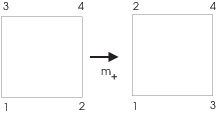
The operation on ![]() is function composition --- do one
rigid motion after another. It's clear that this is a binary
operation, but I need to establish a convention concerning how I will
write the operation. I will write
is function composition --- do one
rigid motion after another. It's clear that this is a binary
operation, but I need to establish a convention concerning how I will
write the operation. I will write
![]()
In other words, I'll apply the motions from right to left. This is
consistent with the usual notation for composing functions: ![]() means g first, then f.
means g first, then f.
The next picture shows the composite ![]() . You can see that
. You can see that ![]() .
.
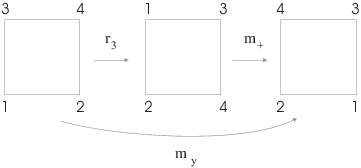
With a little bit of patience (and perhaps a little cardboard
square), you can generate the multiplication table for ![]() . Here it is:
. Here it is:
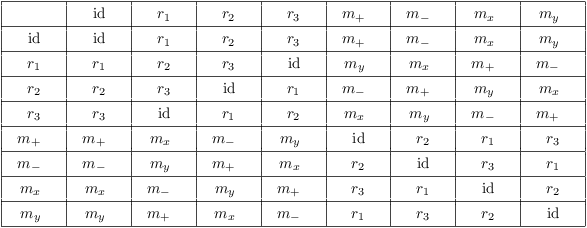
This table illustrates a number of ideas.
From the table, it is apparent that ![]() is not abelian. For example,
is not abelian. For example, ![]() , but
, but ![]() .
.![]()
The next proposition contains the result I mentioned about rows and columns of finite group tables.
Proposition. In a finite group operation table, each row or column contains each element of the group exactly once.
Proof. Consider the row for the element ![]() . If x occurs in the b and c-columns, this means that
. If x occurs in the b and c-columns, this means that
![]() . Multiply this equation on the left by
. Multiply this equation on the left by
![]() :
:
![]()
That is, the b and c-columns are actually the same column. Hence, each row contains a given element at most once.
On the other hand, consider again the row for ![]() . Take
. Take ![]() ; does x occur in this
row? Well,
; does x occur in this
row? Well, ![]() , so x occurs in the
column for
, so x occurs in the
column for ![]() . That is, every element of G
occurs in the row for a.
. That is, every element of G
occurs in the row for a.
All together, every element of G occurs exactly once in the row for
a. A similar argument works for columns.![]()
Example. ( Products of groups) Consider the following set:
![]()
Is this a group under componentwise-addition ("vector addition")?
What about componentwise-multiplication?
![]() is a group under
componentwise-addition. This is really just addition of
two-dimensional (integer) vectors: For example,
is a group under
componentwise-addition. This is really just addition of
two-dimensional (integer) vectors: For example,
![]()
It's associative, the identity is ![]() , and the inverse of
, and the inverse of ![]() is
is ![]() .
.
![]() is not a group under
componentwise-multiplication. Here the operation would look like
this:
is not a group under
componentwise-multiplication. Here the operation would look like
this:
![]()
It's associative, and the identity is ![]() . However, many pairs don't have multiplicative
inverses. For example, suppose
. However, many pairs don't have multiplicative
inverses. For example, suppose
![]()
Then
![]()
The first equation has no integer solutions, and the second says
"![]() ", so I have two contradictions!
", so I have two contradictions!![]()
Notes: If you use the notation "![]() " for this group, don't confuse it with
"
" for this group, don't confuse it with
"![]() ".
".
You can replace ![]() with
with ![]() or
or ![]() or
or ![]() . Thus,
. Thus, ![]() ,
, ![]() , and
, and ![]() are all groups under
componentwise-addition (and not under componentwise-multiplication).
And you can extend this to more than two factors: For example
are all groups under
componentwise-addition (and not under componentwise-multiplication).
And you can extend this to more than two factors: For example ![]() is a group under
componentwise-addition.
is a group under
componentwise-addition.
Example. ( Matrix groups) Consider the following sets:
![]() -
- ![]() matrices with
real entries
matrices with
real entries
![]() -
- ![]() invertible
matrices with real entries
invertible
matrices with real entries
Are these groups under matrix addition? Matrix multiplication?
![]() is a group under matrix addition. Matrix
addition is associative. The identity for addition is the
is a group under matrix addition. Matrix
addition is associative. The identity for addition is the ![]() zero matrix:
zero matrix:
![$$\left[\matrix{ 0 & 0 & \cdots & 0 \cr 0 & 0 & \cdots & 0 \cr \vdots & \vdots & & \vdots \cr 0 & 0 & \cdots & 0 \cr}\right]$$](examples-of-groups162.png)
The inverse of a matrix A is its negative ![]() (negate all the entries of A).
(negate all the entries of A).
![]() is not a group under matrix multiplication.
Matrix multiplication is associative, and the identity is the
is not a group under matrix multiplication.
Matrix multiplication is associative, and the identity is the ![]() identity matrix:
identity matrix:
![$$\left[\matrix{ 1 & 0 & \cdots & 0 \cr 0 & 1 & \cdots & 0 \cr \vdots & \vdots & & \vdots \cr 0 & 0 & \cdots & 1 \cr}\right]$$](examples-of-groups166.png)
But many matrices don't have inverses under multiplication --- for example, the zero matrix above.
With ![]() , the situation is reversed.
, the situation is reversed. ![]() is a group under matrix multiplication.
Matrix multiplication is associative, and the identity is the
is a group under matrix multiplication.
Matrix multiplication is associative, and the identity is the ![]() identity matrix.
identity matrix.
By definition, ![]() consists of invertible
matrices, so every element has a multiplicative inverse.
consists of invertible
matrices, so every element has a multiplicative inverse.
You should know from linear algebra that matrix multiplication is
not commutative. Thus, ![]() is not an
abelian group. (Can you give a particular example of noncommuting
is not an
abelian group. (Can you give a particular example of noncommuting
![]() matrices?)
matrices?)
However, ![]() is not a group under matrix
addition. In fact, you can add two invertible matrices and get a
non-invertible matrix; for example,
is not a group under matrix
addition. In fact, you can add two invertible matrices and get a
non-invertible matrix; for example,
![]()
Thus, addition of matrices is not a binary operation on ![]() .
.![]()
Note: You can replace "![]() " in this
example with
" in this
example with ![]() ,
, ![]() ,
, ![]() --- in fact, you
can even use the integers mod n like
--- in fact, you
can even use the integers mod n like ![]() . In the case of
. In the case of ![]() , you add and
multiply elements of
, you add and
multiply elements of ![]() mod 5. And more
generally, you can replace "
mod 5. And more
generally, you can replace "![]() " with any commutative ring with identity (I'll discuss rings
later).
" with any commutative ring with identity (I'll discuss rings
later).
Example. ( Groups of order
2) Suppose G is a group of order 2: ![]() . Construct the multiplication table for G.
. Construct the multiplication table for G.
Since G has two elements, ![]() , where 1 is
the identity and
, where 1 is
the identity and ![]() is another element. a must have an
inverse; since
is another element. a must have an
inverse; since ![]() , the inverse of a is not 1.
Therefore, the inverse of a is a, and
, the inverse of a is not 1.
Therefore, the inverse of a is a, and ![]() . The multiplication table for G looks like
this:
. The multiplication table for G looks like
this:

This group is called ![]() , the cyclic
group of order 2. Here is another table for the same group:
, the cyclic
group of order 2. Here is another table for the same group:

In this case, I think of ![]() as the set
as the set ![]() , with addition mod 2.
, with addition mod 2.
What do I mean when I say that they're "the same group"?
I mean that I can get the second table from the first this way:
![]()
This is an example of an isomorphism --- a
function which "matches up" elements of one group with
another, so the group table is preserved. (I'll make this more
precise later.) Isomorphic groups are the same as groups. In
this sense, ![]() is the only group of
order 2.
is the only group of
order 2.![]()
Example. ( Groups of order
3) Suppose that G is a group and ![]() . Construct the multiplication table for G.
. Construct the multiplication table for G.
Let ![]() , where 1, a, and b are different
elements.
, where 1, a, and b are different
elements.
If ![]() , then
, then ![]() , or
, or ![]() , contradicting the fact that a and 1 were
distinct elements. If
, contradicting the fact that a and 1 were
distinct elements. If ![]() , then
, then ![]() (because
(because ![]() gives
gives ![]() , or
, or ![]() , contradicting the
fact that b and 1 were distinct elements). But then
, contradicting the
fact that b and 1 were distinct elements). But then ![]() , so
, so ![]() , the same contradiction as before. Hence,
, the same contradiction as before. Hence, ![]() . Using the principle that each row or column of a
multiplication table contains each element exactly once, I can fill
in the rest of the table:
. Using the principle that each row or column of a
multiplication table contains each element exactly once, I can fill
in the rest of the table:
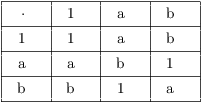
This is ![]() , the cyclic group of order 3.
Here is another table for the same group:
, the cyclic group of order 3.
Here is another table for the same group:
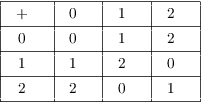
These two tables give groups which are isomorphic. Up to isomorphism,
there is only one group of order 3, namely ![]() .
.
There are two groups of order 4, one group of order 5, two groups of
order 6, and one group of order 7. No one knows a practical formula
for determining how many groups of order n there are. And the method
of the preceding examples --- essentially, trial and error --- is
untenable once n gets large.![]()
Copyright 2016 by Bruce Ikenaga